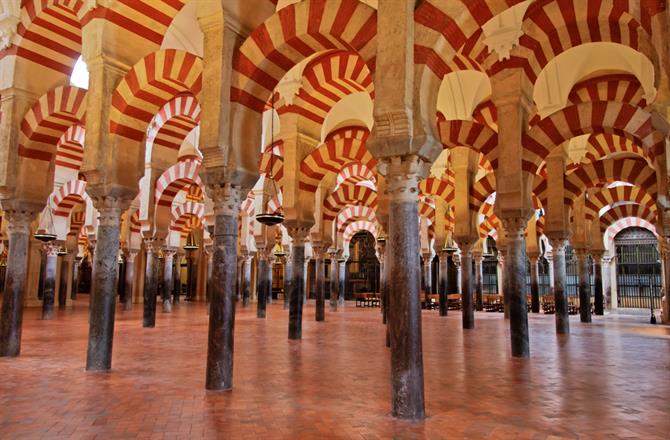Andalusia is a region of great cultural richness, where history and traditions blend. Much of the unique charm of this part of Spain comes from the long centuries of coexistence between the Christians, Jews, Muslims and Gypsies, offering unique surroundings and remarkable landmarks.
Throughout the cities of Andalusia, cultural fusions have influenced the architecture in different and directly visible ways. Granada, for example, is strongly influenced by the Moorish style, which can especially be seen through the famous and beautiful Alhambra Palace. Sevilla, on the other hand, represents the symbolic and political centre of the Christian crown, all the while holding onto some parts of the Andalusian Gypsy tradition.
One of the most prominent cases of the coexistence of contrasting cultures over thousands of years is the city of Córdoba. This city's heritage can also be primarily observed through it's varied and recognizable architecture.
Córdoba's city centre and the Mezquita

The former capital of the Roman province of Baetica, Córdoba was under Arab and Berber rule from the year 711. The city quickly reached a considerable size and prestige, so much so that by year 1000 (end of the construction of the famous Córdoba Mosque, La Mezquita), it was one of the most flourishing cities in all of Europe and an important centre for learning, with a university and a library.
The Roman Bridge or Puente Romano, which until today allows access to the city centre, is the main legacy of the Roman period, while another of Córdoba's most well-known symbols is La Mezquita, an incredible architectural complex and the largest temple to be built in Muslim Spain.

When you enter this amazing building, you will first find yourself in El Patio de los Naranjos (Patio of Orange Trees), a courtyard with a green garden, scrupulously-lined orange trees and refreshing fountains used for purification rituals.
Inside, more than 850 columns structure the space, creating a charming Arabesque atmosphere that contrasts with the Renaissance choir that is integrated into the mosque. This "intrusive" construction is the result of a merge between the mosque and the neighbouring Christian building, the Episcopal Palace, which symbolically shows the historical transfer of Moorish power to the Christians that took place in the thirteenth century.
Nearby the Mezquita is the old Jewish quarter. Here you can visit a synagogue or stroll through the narrow streets lined by whitewashed houses with flowered balconies. Getting lost in the old town of Córdoba is a true pleasure because it has retained its charm despite the growing number of tourist shops.
There are also other monuments that are worth visiting, such as the remains of the Arabic Baths, located in the Santos Martires gardens, just a few meters west of the Mezquita. These Arabic Baths hold archaeological findings dating back to the times of the Romans and the Moors.
The whole of the Casco Antiguo, the old city, is still surrounded by ancient Roman walls. The old city was declared a UNESCO World Heritage Site and is, in large part, a pedestrian zone that allows visitors to stroll through gardens and discover the many churches, monuments, and bridges that cross the Guadalquivir river.
Festivals and events in Cordoba

Córdoba is undoubtedly one of the most culturally active Andalusian cities, with events and celebrations that mark its cultural calendar throughout the year. These numerous events are ideal moments to visit Córdoba and experience a special celebration while exploring the city, its monuments, and timeless Andalusian traditions.
Of the most significant events taking place in Córdoba throughout the year, the following are a few highlights:
- Semana Santa (Easter Holy Week). As in most Andalusian cities, Córdoba's Holy Week processions are an impressive sight, even if they do not have the same magnitude and zeal as the processions in Málaga or Sevilla.
- The Córdoba Carnival is characterized by parades and Chirigota concerts (songs with a satirical and humorous tone) in the Gran Teatro de Córdoba (Córdoba's Grand Theatre).
- La Batalla de las Flores (The Battle of Flowers) takes place on the last Sunday of April and consists of a parade of floats from which flowers are thrown to the public. This event marks the beginning of celebrations that take place during the month of May in Córdoba.
- The month of May is an ideal month to visit because it is the most festive of the year. The city is transformed into an explosion of colours with its first two festivals: Cruces de Mayo (May Cross) and the Fiesta de los Patios de Córdoba (the Córdoba Patio Festival). May Cross is celebrated during the first week of May and is characterized by a large flowered cross set up in the city's gardens. The Córdoba Patios festival takes place during the following weeks. Residents decorate their private patios during this festival and open them to be seen by the public, resulting in a contest to recognize the most beautiful patio.
- El Festival de la Guitarra (Guitar Festival) takes place in mid-July. This is an important international guitar festival, with guitar competitions and flamenco concerts, as well as contemporary music.
- El Dia de San Rafael is the day of Saint Raphael, held on the 24th of October. This is a traditional gastronomical festival that involves Córdoba, as well as neighbouring municipalities.
